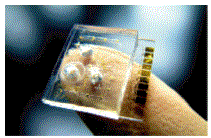| |
|
|
| |
|
● Tissue engineering |
Lab on a chip research

Electrochemical microsystem for monitoring of ammonia metabolism of hepatocyte |
| Objective |
The progress of microfluidic technology has produced successful devices
in various fields. Like in many other applications, the capability for
the evaluation of evaluating cellular functions with a minimum amount of
cells and reagents will also be beneficial in fields including stem cell
research, drug screening, and cell biology. To this end, an issue is on-chip
cultivation, sampling, and monitoring of changes of physical and/or chemical
parameters. To realize these functions, we used electrochemical principles.
In this study, we fabricated a microsystem that can carry out necessary
procedures for monitoring of ammonia metabolism of hepatocytes. |
| Results |
The microsystem consisted of a glass substrate with valve electrodes and
sensing electrodes, and a polydimethylsiloxane (PDMS) substrate with microflow
channels and a culture chamber (Fig.1). Electrowetting-based valves controlled
transport of extracted culture medium and an electrolyte solution of an
air-gap Severinghaus-type ammonia sensor. The extracted culture was transported
to the sensing area one by one with a predetermined interval and the ammonia
concentration was measured using the sensor. The decrease in the ammonia
concentration as a result of metabolism could clearly be followed on the
chip (Fig.2). The amount of cells required in the system was less than
one-hundredth of that in conventional analyses. 
Fig. 1 Ammonia monitoring chip
 Fig. 2 Monitoring of ammonia metabolism of hepatocytes. Hepatocytes were
seeded at densities of 11 cells/mm2 (○), 115 cells/mm2 (□) in the microsystem,
and 11 cells/mm2 using a commercial kit (●).
Fig. 2 Monitoring of ammonia metabolism of hepatocytes. Hepatocytes were
seeded at densities of 11 cells/mm2 (○), 115 cells/mm2 (□) in the microsystem,
and 11 cells/mm2 using a commercial kit (●).
|
| [Reference] |
| W. Satoh, S. Takahashi, F. Sassa, J. Fukuda, and H. Suzuki, On-chip culturing
of hepatocytes and monitoring their ammonia metabolism, Lab on a Chip (IF=6.26),
9(1), pp.35-7 (2009) |
|
| ● Vascular |
| ● Liver |
| ● Hair |
| ● Pacnreas |
| ● Bone |
| ● Lab Chip/ MEMS |
| ● Surface modification |
| ● Microbe |
| |
| |
|
|
| |

|
|
 Fukuda Lab, Faculty of Engineering, Yokohama National University Fukuda Lab, Faculty of Engineering, Yokohama National University |
|